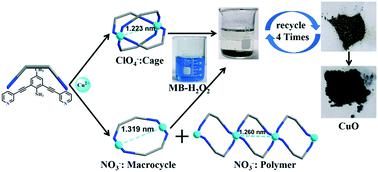当前位置:
X-MOL 学术
›
CrystEngComm
›
论文详情
Our official English website, www.x-mol.net, welcomes your feedback! (Note: you will need to create a separate account there.)
Synthesis, structure, and heterogeneous Fenton reaction of new Cu(II)-based discrete Cu2Lx coordination complexes
CrystEngComm ( IF 3.1 ) Pub Date : 2020-10-30 , DOI: 10.1039/d0ce01363c Qi-Bao Wang 1, 2, 3, 4 , Zi-Yan Jing 1, 2, 3, 4 , Xiang-Ming Hu 2, 4, 5 , Wen-Xin Lu 1, 2, 3, 4 , Peng Wang 1, 2, 3, 4
CrystEngComm ( IF 3.1 ) Pub Date : 2020-10-30 , DOI: 10.1039/d0ce01363c Qi-Bao Wang 1, 2, 3, 4 , Zi-Yan Jing 1, 2, 3, 4 , Xiang-Ming Hu 2, 4, 5 , Wen-Xin Lu 1, 2, 3, 4 , Peng Wang 1, 2, 3, 4
Affiliation

|
Discrete and polymeric coordination complexes, namely [Cu2L4(ClO4)4]·2CH2Cl2·CH3OH (1), [Cu2L2(NO3)4(CH3OH)2] (2) and {[Cu2L4(NO3)4]}n (3), were obtained using bridged pyridine ligand 4-methyl-2,6-bis(pyridinyl-3-ethynyl)aniline (L) and Cu(II) salts in CH2Cl2/MeOH. The structure of the Cu2L4 cage or Cu2L2 macrocycle was generated depending on the selection of the anion (ClO4−/NO3−). The heterogeneous Fenton reaction experiments using H2O2 showed that discrete coordination complexes are good photocatalysts in which the Cu–N bond plays a major role in the photocatalytic degradation. The degradation mechanism could be described as a synergistic process of the Fenton reaction and high-valence copper ions using t-butanol as the hydroxyl radical scavenger. The photocatalytic degradation of methylene blue (MB) experiments showed that the photodegradation efficiency of the coordination complexes is higher than that of the polymeric Cu-MOFs.
中文翻译:

新的基于Cu(II)的离散Cu2Lx配位化合物的合成,结构和非均相Fenton反应
离散和高分子配位络合物,即[Cu 2 L 4(ClO 4)4 ]·2CH 2 Cl 2 ·CH 3 OH(1),[Cu 2 L 2(NO 3)4(CH 3 OH)2 ](2)和{[Cu 2 L 4(NO 3)4 ]} n(3),是使用桥联吡啶配体4-甲基-2,6-双(吡啶基-3-乙炔基)苯胺(L)和Cu(II)CH 2 Cl 2 / MeOH中的盐。的Cu的结构2大号4笼或Cu 2大号2取决于阴离子的选择产生大环化合物(CLO 4 - / NO 3 - )。使用H 2 O 2的非均相Fenton反应实验表明,离散的配位配合物是良好的光催化剂,其中Cu-N键在光催化降解中起主要作用。降解机制可被描述为使用芬顿反应和高价的铜离子的协同过程吨-丁醇作为羟基自由基清除剂。亚甲基蓝(MB)的光催化降解实验表明,配位配合物的光降解效率高于聚合型铜-MOF。
更新日期:2020-11-25
中文翻译:

新的基于Cu(II)的离散Cu2Lx配位化合物的合成,结构和非均相Fenton反应
离散和高分子配位络合物,即[Cu 2 L 4(ClO 4)4 ]·2CH 2 Cl 2 ·CH 3 OH(1),[Cu 2 L 2(NO 3)4(CH 3 OH)2 ](2)和{[Cu 2 L 4(NO 3)4 ]} n(3),是使用桥联吡啶配体4-甲基-2,6-双(吡啶基-3-乙炔基)苯胺(L)和Cu(II)CH 2 Cl 2 / MeOH中的盐。的Cu的结构2大号4笼或Cu 2大号2取决于阴离子的选择产生大环化合物(CLO 4 - / NO 3 - )。使用H 2 O 2的非均相Fenton反应实验表明,离散的配位配合物是良好的光催化剂,其中Cu-N键在光催化降解中起主要作用。降解机制可被描述为使用芬顿反应和高价的铜离子的协同过程吨-丁醇作为羟基自由基清除剂。亚甲基蓝(MB)的光催化降解实验表明,配位配合物的光降解效率高于聚合型铜-MOF。


























 京公网安备 11010802027423号
京公网安备 11010802027423号